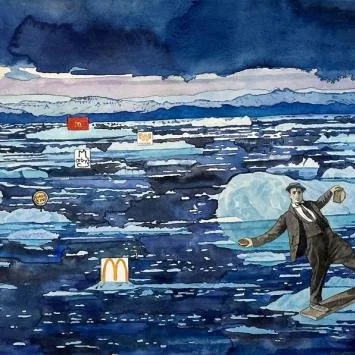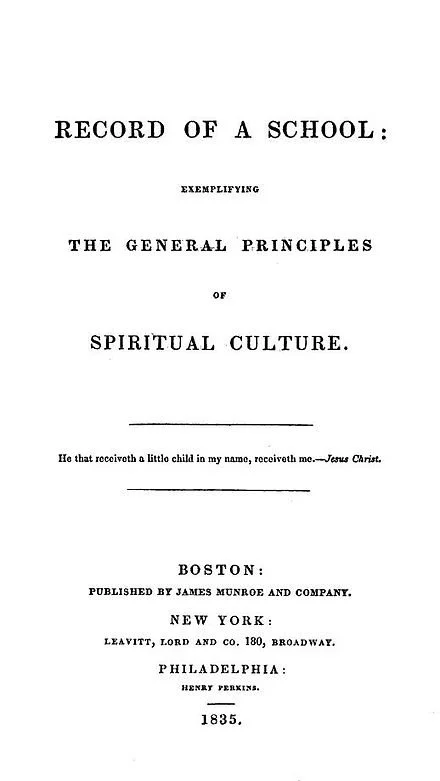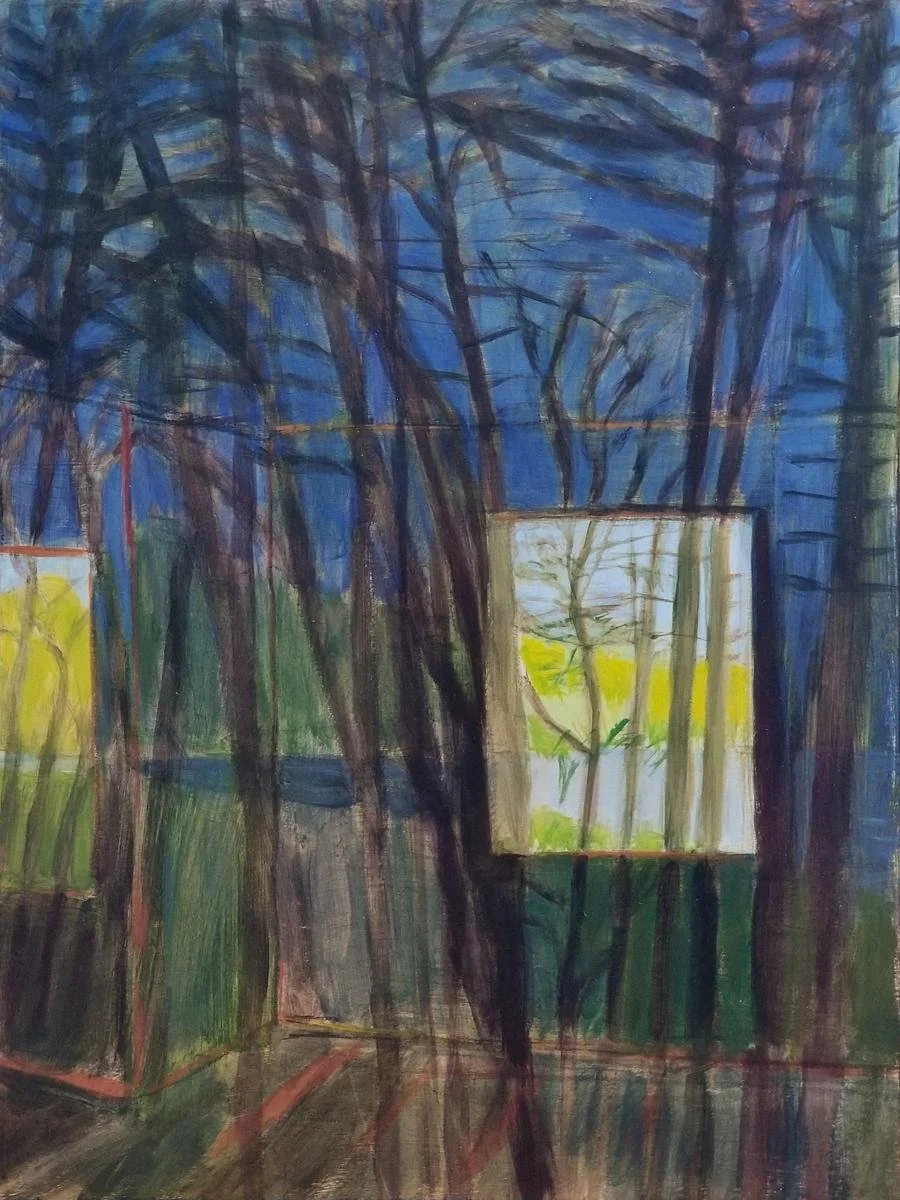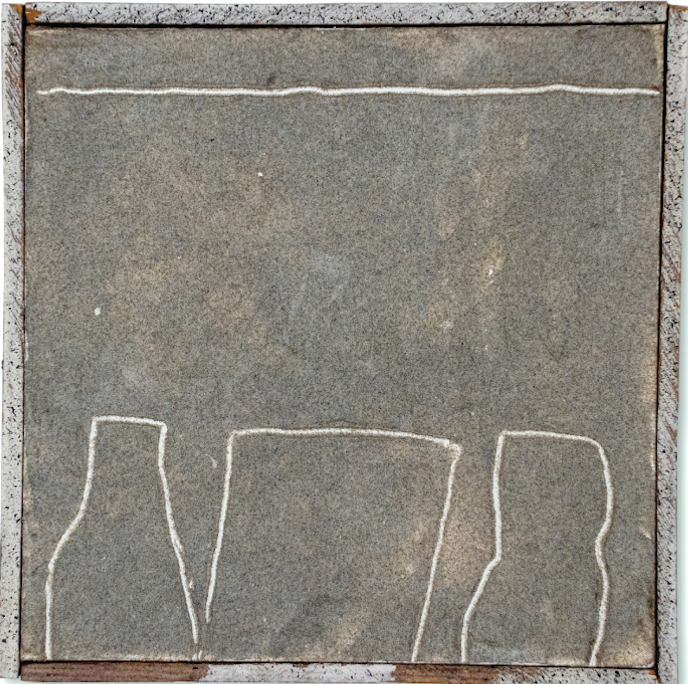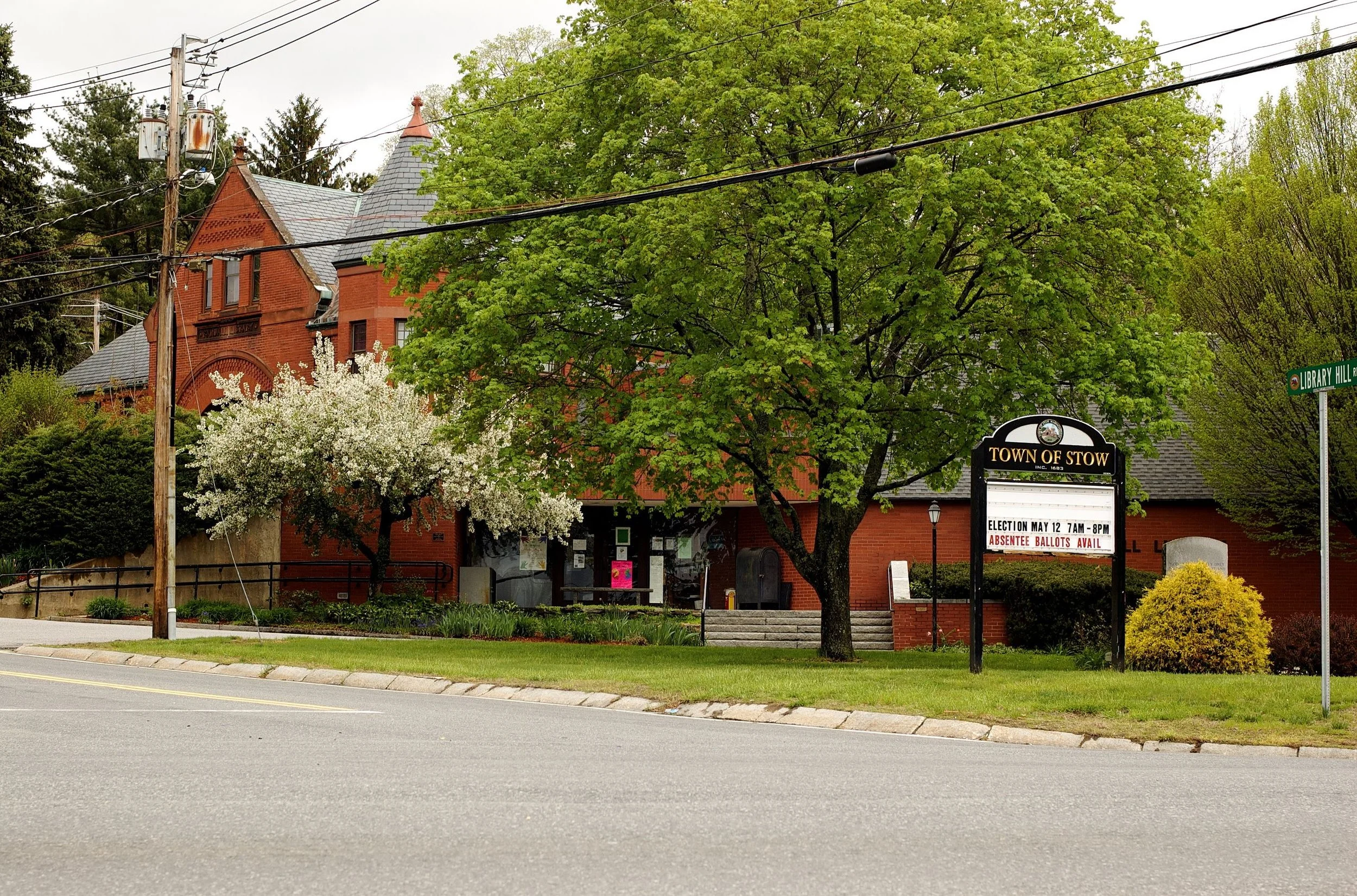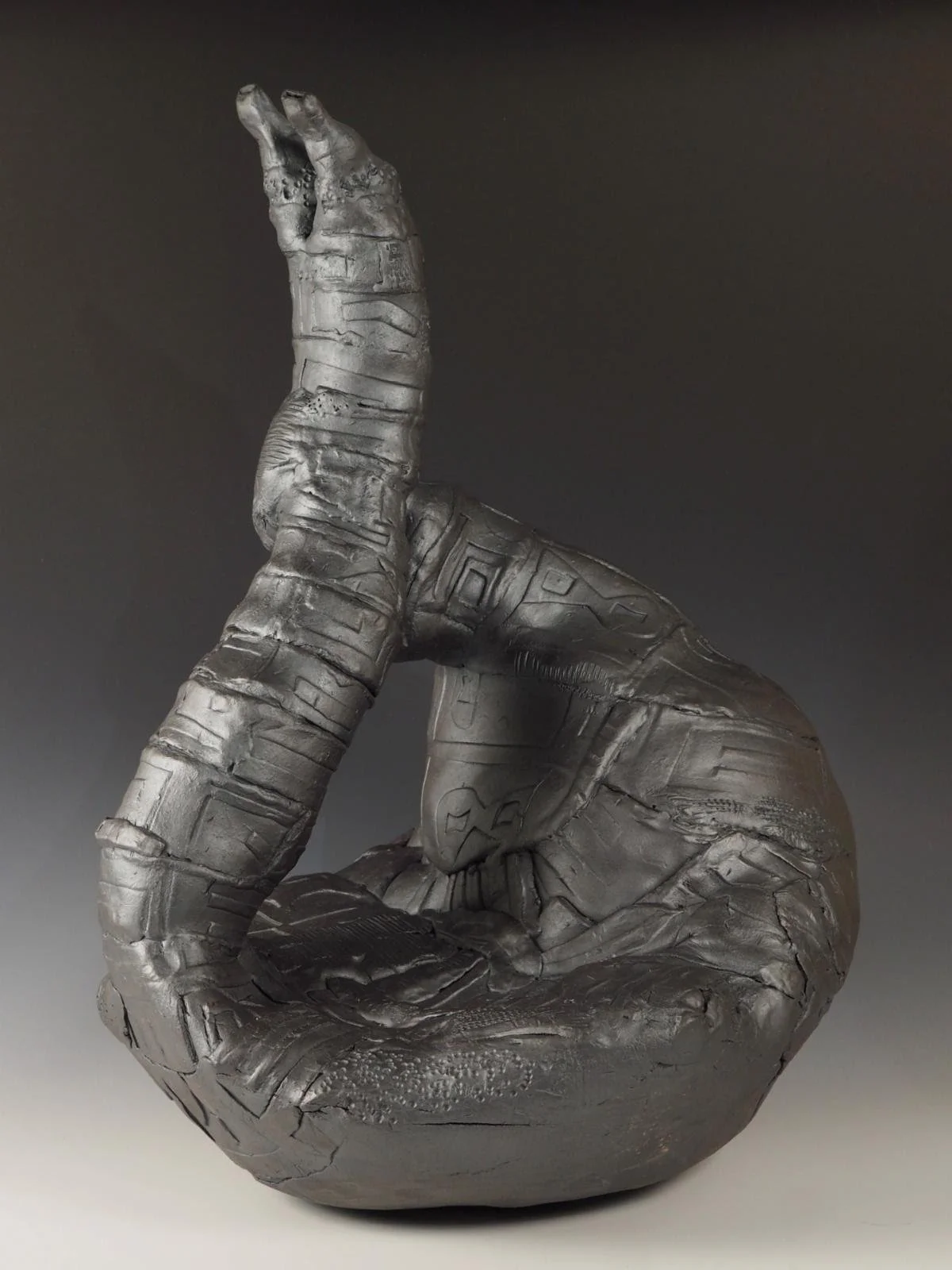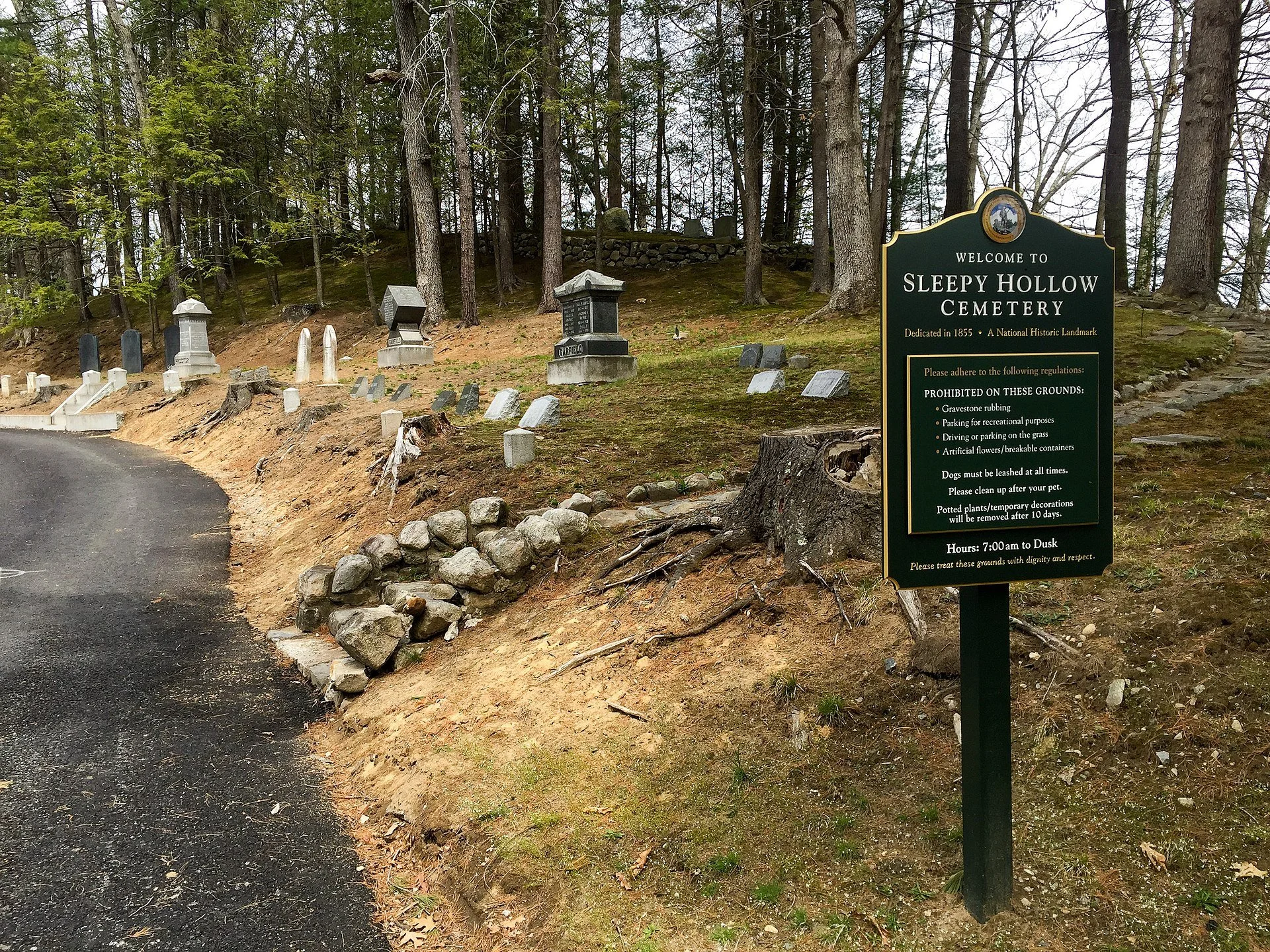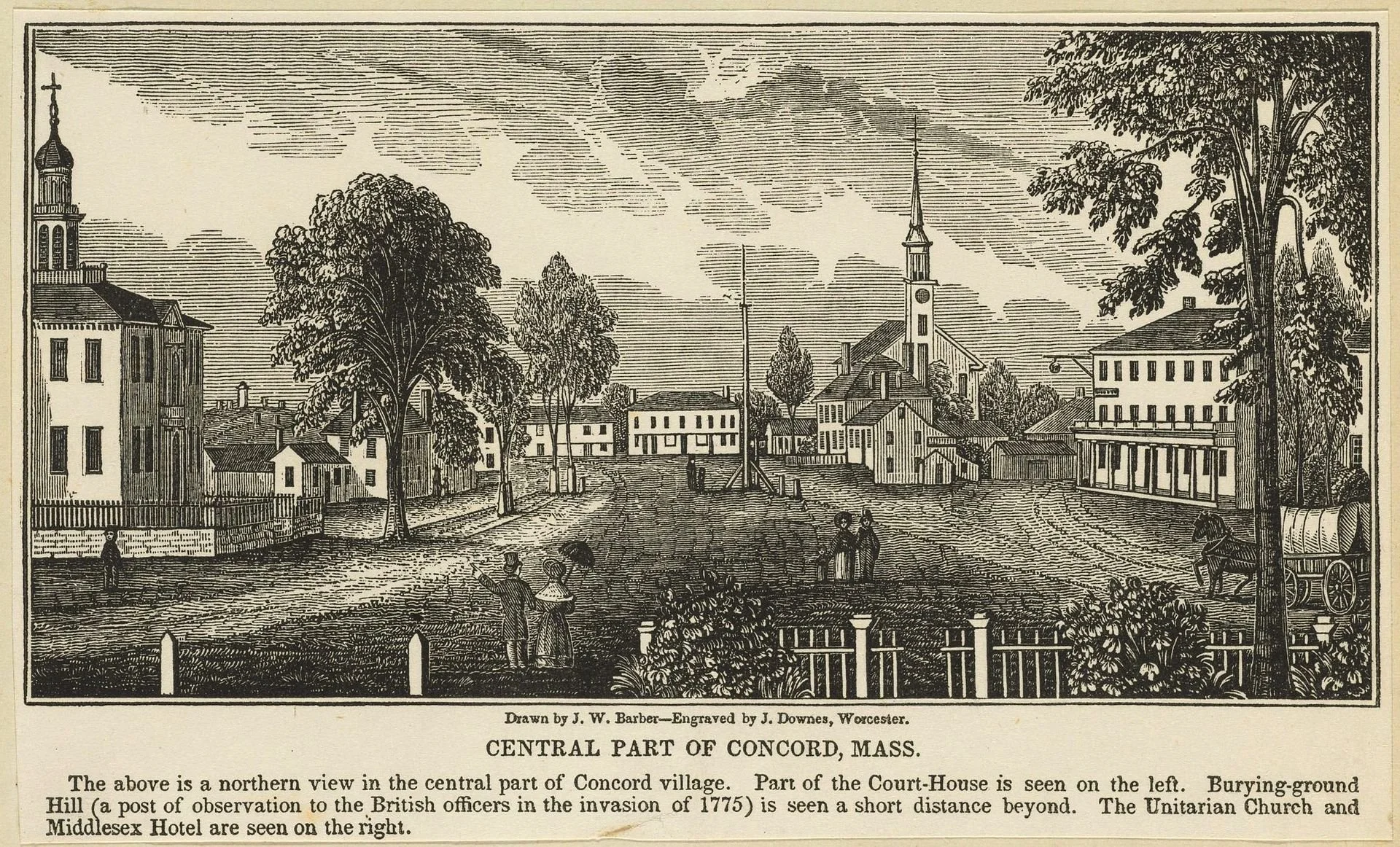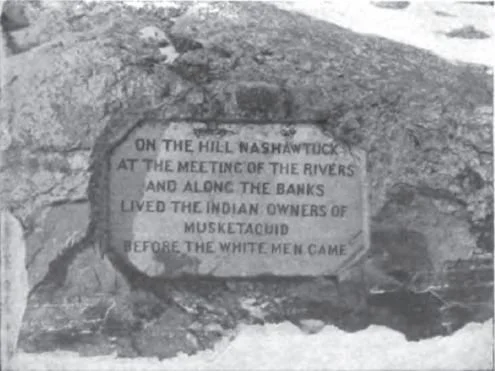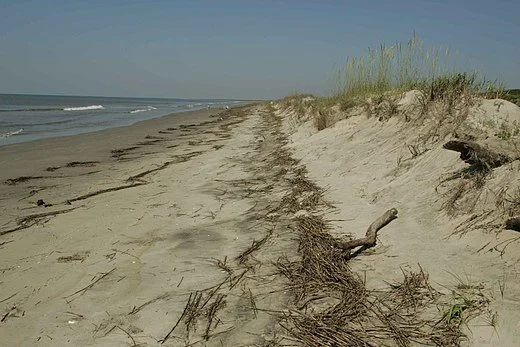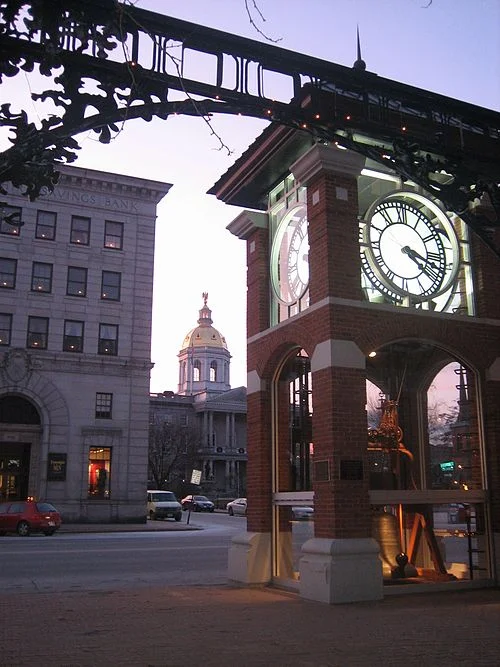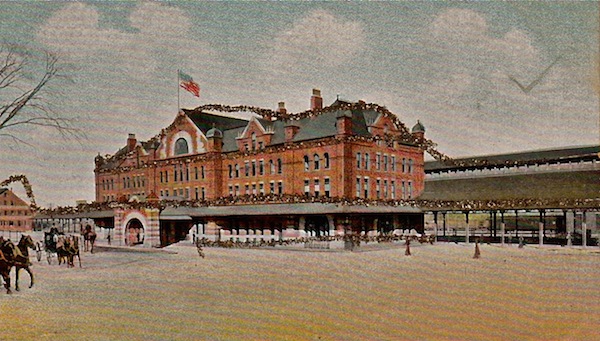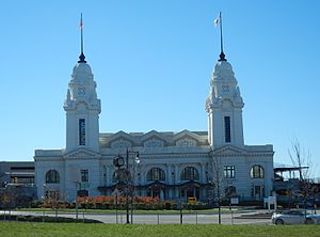
Colors at Walden Pond
“Blue Water” (oil on canvas), by Patricia Crotty, in her show “Sky Water: Reflections on Walden Pond”, at Walden Pond State Reservation Gallery, Concord, Mass., through April 30.
The gallery says:
“The colorful abstract paintings and collages of local artist Patricia Crotty are inspired by the connection with nature that Walden Pond {made internationally famous by Henry David Thoreau’s book Walden} provides visitors. They celebrate the beauty of nature in all of its forms and seasons. Co-sponsored by Friends of Walden Pond. The exhibit is free; parking fees apply.’’
Eat beef and melt
“Patty Melt” (watercolor), by Jane Goldman, in her show “Global Warming Series (2018-2023),’’ at Umbrella Arts Center, Concord, Mass., through May 5.
She explains:
“Global Warming Series (2018-2023)’’ is an ongoing series of watercolor monotypes on 22” x 30” Arches Hot Press watercolor paper. Dark humor sets the tone, inspired by silent-film comedians, especially the great Buster Keaton (above). In this context, the silent comedians represent all of us, experiencing global crises in slow motion. Like them, we watch the planet beset with catastrophe in ever faster motion.
“Some pieces in the series personalize the consequences of our behavior. The painting here depicts Keaton, burger in hand, amidst glacial melt, due in part to global beef consumption. Other works, such as ‘Clean Air Act,’ point out the obtuseness of ignoring our present reality. And in some works, such as ‘Teetering on the Edge,’ our Everyman is depicted in a situation right before catastrophe occurs, implying that there’s still time to alter the outcome.’’
'Inhabitant of the Mind'
Amos Bronson Alcott created the reformist Temple School in Boston.
“I perceive that I am neither a planter of the backwoods, pioneer, nor settler there, but an inhabitant of the Mind, and given to friendship and ideas. The ancient society, the Old England of New England, Massachusetts for me.”
— Amos Bronson Alcott (1799-1888), teacher, writer and reformer and a member of the Transcendentalists group based in Concord, Mass., where he is buried in the famous Sleepy Hollow Cemetery with other intellectual luminaries of the time.
The trees that remain
‘‘Outside In” (acrylic on panel), by Concord, Mass.-based artist Irene Stapleford, in her show “Sightlines,’’ at Galatea Fine Art, Boston, Nov. 30-Dec. 31.
She says:
"From my modest home of more than a decade, I've appreciated the opportunity to observe and record some of my neighborhood's sightlines in paintings. Wildlife and trees, views of the nearby pond, and quiet peacefulness have reigned — until recently.
“Tremendous upheaval in my immediate surroundings has infused my plein air painting documentation with new urgency. Amid tree clearing, land excavation and construction activity adjacent to my home, I have continued to observe and paint. Many trees I've studied remain, but some are gone, cut down in their prime to make way for large new residences.
“As I experience these changing sightlines, the trees which remain have become my focus thanks to their steady, enduring, majestic and graceful presence.’’
‘Transcendent shapes’
“Remains” (1970) ( sand and gel medium), by Merrimac, Mass.-based artist Rhoda Rosenberg, in her show “Shapes of Time: 1968-2022,’’ at Concord Art, Concord, Mass., through Dec. 17.
The gallery says:
“Rosenberg’s work focuses on deeply rooted ties with family members and the power of an object’s shape to convey feeling. Concerned with emotion and meaning behind her subject matter more than representational rendering, she has concentrated on transcendent shapes throughout her career, seeing beyond the form of an object and getting to the feeling it evokes instead.’’
Merrimac Town Hall near Merrimac Square
— Photo by Doug Kerr
Colorful memories
Brenda Cirioni, “Reminiscence” (mixed media), by Brenda Cirioni, in her joint show with Ellen Harasimowicz, “Terra Firma,’’ at Three Stones Gallery, Concord, Mass., through June 18.
— Image courtesy: Three Stones Gallery
#Brenda Cironi #Three Stones Gallery
The gallery says that Cirioni's abstract artwork, inspired by her garden and using natural tones and shapes, is paired with the documentary photography of Harasimowicz. Ms. Cirioni lives in Stow, Mass.
Town center of Stow
— Photo by Tim Pierce
‘Resolute optimism’ in face of climate threats
“Feeling the Heat” (thermal imaging art), by Adam Sebire, in the multimedia show “Points of Return,’’ at the Umbrella Arts Center, Concord, Mass., May 1-June 25.
The Umbrella Visual Arts program, in collaboration with A La Luz, is featuring the work of 27 international artists, in the first physical exhibition of the acclaimed online exhibition of the same name.
The arts center says:
“This environmental art exhibition has The Umbrella divided into themed spaces. A journey has been mapped out to give visitors fresh and engaging insights into wide-ranging aspects of the climate crisis, with its end destination that of resolute optimism. For while it may seem that we are racing toward a closing act, as our planet’s average temperature rises year-to-year, solutions remain within sight. We have not yet reached that dreaded ‘point of no return’ and artists can present scientific data in new ways. Through dynamic display and crossing several artistic disciplines, this show provides commentary, reflection, and creative restorative strategies.’’.
‘Landscapes’ in different media
Snakesound” (clay), by Liz Newell, in the group show “Earth, Sea & Sky,’’ at the Umbrella Arts Center, Concord, Mass., Jan. 8-Feb. 11.
— Photo courtesy artist.
The gallery says:
“‘Earth, Sea & Sky’ is a collection of artworks by Suzanne Hill, Liz Newell and Barbara Willis. Each artist approaches the theme of ‘landscapes’ through their own medium. Their unique interpretations of the world around us are woven in fabric or built from, clay, the very Earth itself. ‘‘
Sleepy Hollow Cemetery, in Concord, a Boston area town that was one of America’s most important cultural centers in the 19th Century. Many famous people are buried there, including Ralph Waldo Emerson, Nathaniel Hawthorne and Henry David Thoreau
— Photo by Kenneth C. Zirkel
Against the world
“Madonna and Child” (mixed media collage on paper, oil, ink, beeswax), by Lexington, Mass.-based artist Sirarpi Walzer, in the joint show “Efflorescence,’’ with Patricia Ganek, at Three Stones Gallery, Concord, Mass., through Aug. 27.
For more information, hit here.
The artist, who is also an engineer, writes on her site:
“My poetic abstractions spring both from meditations on nature and from memories that are distilled into single dramatic moments. The energetic surfaces imply an ongoing tension between freedom and containment, edging the viewer closer to that place where chaos can erupt into clarity. The color white suggests notions of purity and simplicity, and unifies the disparate objects. The deliberate juxtapositions of forms and exaggerations of color choices, provide clues to content and interpretation.’’
1840’s lithograph
Ready for anything
“Wilamaya Series: Harvest” (digital collage), by Alyn Carlson, in her joint show with Kevin Kusiolek and Colleen Pearce titled “Portraits: urban + natural + imagined,’’ at Three Stones Gallery, Concord, Mass., through July 10.
The gallery says: “The collage portraits of featured artist Alyn Carlson imagine strong female personas empowered in their environments."
She works in a converted rope-making factory in New Bedford.
Photo of Egg Rock inscription, in Concord, circa 1900
The port of New Bedford.
— Photo by gerrydincher
‘Ever-evolving aggregate state’
“Shiver Me Timbers,’’ by Michael MacMahon, in his show “Wrack Line,’’ at the Umbrella Arts Center, Concord, Mass., through Oct. 31.
The gallery says:
“Wrack lines are linear piles of debris (both natural and manmade) that become situated on the edge of the landscape. The result of their coming in contact with and carried along by the forces of incoming waves and tides.
“The merging of economic need, curiosity, seen and unseen forces have brought peoples from different cultures and communities into contact across great distances. Whether through clashes or cooperative endeavors, these convergences have brought about the adaptation of living within a contemporary culture that is an ever-evolving aggregate state. Ideas of the self/home/the domestic space and the landscape come together in the paintings on view.’’
Debris in a wrack line
Historic shots
“I now live in the town of Concord, Massachusetts, not far from the Old North Bridge, where the American Revolution began. Whenever I take visitors to see the monument, and stand before the marble shaft (above) reading that lovely inscription which commemorates ‘the shot heard round the world,’ I think privately of Bobby Thomson’s (below) home run.’’
From Doris Kearns Goodwin’s (born 1943) Wait Till Next Year: A Memoir
Bobby Thomson (1923-2010) in 1951. The "Shot Heard 'Round the World" was a game-winning home run by New York Giants outfielder and third baseman Bobby Thomson off Brooklyn Dodgers pitcher Ralph Branca at the Polo Grounds in New York City on Oct. 3, 1951, to win the National League pennant. Thomson's three-run homer came in the ninth inning of the third game of a three-game playoff for the pennant in which the Giants trailed, 4–1 entering the ninth, and 4–2 with two runners on base at the time of Thomson's at-bat.
‘Upon a winter’s morn’
Packed in my mind lie all the clothes
Which outward nature wears,
And in its fashion's hourly change
It all things else repairs.
In vain I look for change abroad,
And can no difference find,
Till some new ray of peace uncalled
Illumes my inmost mind.
What is it gilds the trees and clouds,
And paints the heavens so gay,
But yonder fast-abiding light
With its unchanging ray?
Lo, when the sun streams through the wood,
Upon a winter's morn,
Where'er his silent beams intrude
The murky night is gone.
How could the patient pine have known
The morning breeze would come,
Or humble flowers anticipate
The insect's noonday hum,—
Till the new light with morning cheer
From far streamed through the aisles,
And nimbly told the forest trees
For many stretching miles?
I've heard within my inmost soul
Such cheerful morning news,
In the horizon of my mind
Have seen such orient hues,
As in the twilight of the dawn,
When the first birds awake,
Are heard within some silent wood,
Where they the small twigs break,
Or in the eastern skies are seen,
Before the sun appears,
The harbingers of summer heats
Which from afar he bears.
“The Inward Morning,’’ by Henry David Thoreau (1817-1862), of Concord, Mass.
Replica of Thoreau’s cabin at Walden Pond, with statue of the writer
'The Old England of New England'
The Wayside, in Concord, Mass., home in turn to the Alcott family, novelist Nathaniel Hawthorne and writer and publisher “Margaret Sidney’’ (a nom de plume )— real name was Harriett Lothrop.
—- Photo by Dadero
“I perceive that I am neither a planter of the backwoods, pioneer, nor settler there, but an inhabitant of the Mind, and given to friendship and ideas. The ancient society, the Old England of New England, Massachusetts for me.”
— Amos Bronson Alcott (1799-1888), an American teacher, writer, philosopher and reformer, father of writer Louisa May Alcott (Little Women, etc.) and member of the famous literary community of Concord, Mass.
'Eaten far in Concord'
Walden Pond, in Concord, Mass., most famous for its association with Henry David Thoreau (1817–1862), whose two years living in a cabin on its shore provided the foundation for Walden; or, Life in the Woods.
Comestible, comprehensible.
Heaped up in digestible portions
Thoreau had eaten far in Concord
And still this knoll
With its floor of puce-colored leaves
under May’s green mist
feeds the visitor….’’
-- From “Walden Once More,’’ by Robert Siegel (1939-2012), American poet and novelist. He spent much of his life in his native Mideast but in his later years he lived in South Berwick, Maine
Martha Bebinger: On a Concord, N.H., street, is it meth or a mental-health problem?
The New Hampshire State House as seen from Eagle Square, in downtown Concord
and WBUR
The dispatch call from the Concord, N.H., police department was brief. A woman returning to her truck spotted a man underneath. She confronted him. The man fled. Now the woman wanted a police officer to make sure her truck was OK.
“Here we go,” muttered Officer Brian Cregg as he stepped on the gas. In less than three minutes, he was driving across the back of a Walmart parking lot, looking for a man on the run.
“There he is,” said Cregg. The officer pulled to a stop and approached a man who fit the caller’s description. Cregg frisked the man, whose name was Kerry. NPR has agreed to use only Kerry’s first name because he may have serious mental health and substance use problems.
“Why were you lying on the ground under a truck?” Cregg demanded.
Kerry, head hanging, rocked back and forth, offering quiet one-line answers to Cregg’s questions. There’s a contest, Kerry said. The prize was a new pickup truck, and he just had to find the truck with a key hidden underneath. He said he had searched three so far.
“Kerry, did you take anything today?” Cregg asked. “You’re not acting right.”
“No, no,” said Kerry, shaking his head forcefully. “I’m just stressed out.”
Cregg watched Kerry, looking for signs — is this meth or a mental health problem? Over the past three or so years, as meth has surged in New Hampshire and across the U.S., it’s become hard to tell. Police in many areas of the country where meth has maintained a steady presence have more experience making an assessment, but in Concord and many parts of the Northeast, the onslaught of meth is new.
Concord police say they need to know whether they’re dealing with a mental-health issue or drugs — or both — because it can make a difference in determining the best response.
Concord may send six to eight officers to subdue someone darting through traffic who is high on meth. The calming techniques these officers learned during training for a mental-health crisis intervention don’t seem to work as well when someone is out of control on methamphetamine. Several officers are recovering from injuries sustained during meth-related calls
“Stay right there for me, all right?” Cregg told Kerry. “I like you too much — stay right there.”
Cregg walked a few steps away from Kerry to speak to one of two other officers called to the scene. It turned out this was the third time in the past few months that alarmed drivers had reported finding Kerry under their car. Cregg decided Kerry’s delusions were mental-health issues and didn’t call for more backup.
Kerry, now cuffed, climbed into the back of Cregg’s cruiser, and they headed for the station. Kerry’s suspected crime: prowling.
“Hey, uh, Kerry — man, you feel like you want to go up to the hospital to speak to somebody?” Cregg asked a version of this question four times.
“No, no,” Kerry said repeatedly, “I’ve been through that route years ago; don’t want to do it again.”
Kerry said later that getting stuck in a hospital emergency room — waiting days, maybe weeks for an opening in a psych treatment program — makes his anxiety much worse.
At the station, Cregg found something that changed his view of the day’s events.
“What is that, Kerry?” Cregg asked, pulling a tiny plastic bag of glistening white shards out of Kerry’s coin pocket. It appeared to be meth. “This explains a lot.”
Cregg said what he thought was psychotic behavior likely had more to do with meth.
But “on that call, they mimicked each other. I wasn’t able to tell at first,” Cregg said.
That may be because Kerry is one of the 9.2 million adults in the U.S. coping with both a mental-health problem and a substance-use disorder. In this particular case, not being able to tell what fueled Kerry’s delusions didn’t cause any problems for him or the police. Things never got out of hand. But Concord Police Chief Bradley Osgood said calls triggered by meth are often more challenging than this one.
“With somebody that’s high on methamphetamine, you want to treat them a little firmer and control them,” Osgood said, “because they often are very volatile and aggressive, and you just want to treat that hostility differently.”
With meth now accounting for 60% of drug seizures in Concord, police say they often default to that firmer approach. Some mental health advocates worry that may mean police are using too much force with their clients. Sam Cochran, a retired major in the Memphis Police Department who co-founded and now helps lead CIT International, a crisis intervention program that includes training for police, said officers aren’t making a diagnosis.
“The officer’s foremost [concern] is ‘How do I open up communications? How do I get compliance in order to accomplish safety?'” Cochran said.
There are visual signs of longer-term meth use that are less likely to show up among mental-health patients: skin wounds and scabs, rotting teeth, dilated pupils. But addiction medicine specialists agree it is difficult to determine what’s going on, at first glance, with someone who appears extremely agitated.
“The possession of methamphetamine may be a clue, but teasing out the acute effects of methamphetamine versus a long-standing mental illness may take a longer period of time,” said Dr. Melissa Weimer, an assistant professor of medicine at Yale School of Medicine. She noted that the effects of meth can last 72 hours or longer.
Surging meth use is relatively new in New England. On the police force, Cochran dealt for years with this issue of meth’s effects mimicking mental health issues. He said slowing things down and diffusing fear can work when dealing with people high on meth.
“But let’s be real, there are some individuals that are so sick,” Cochran said, that “officers find themselves having to act immediately to protect safety. Sometimes that may mean a hands-on approach.”
Cochran and another mental-health advocate, Dr. Margie Balfour, an associate professor of psychiatry at the University of Arizona, say the goal is to only use force as a last resort.
“And then, ideally,” Balfour said, “whether it’s meth or mental health or both … you’re going to be able to take that person to somewhere where they are going to get treatment — and not to jail.”
Balfour is also chief of quality and clinical innovation at Connections Health Solutions. The organization operates a network of psychiatric crisis centers in Arizona where, instead of making an arrest, police can drop off anyone 24 hours a day who is out of control on meth or who has a mental-health condition. Balfour said 20% of adults seen at Connections test positive for meth.
Kerry was due last week in a New Hampshire court where a judge could have ordered drug treatment or an evaluation. Kerry didn’t show up for that arraignment — but said he is trying to reschedule.
This story is part of a partnership that includes WBUR, NPR and Kaiser Health News.
Martha Bebinger, WBUR: marthab@wbur.org, @mbebinger

